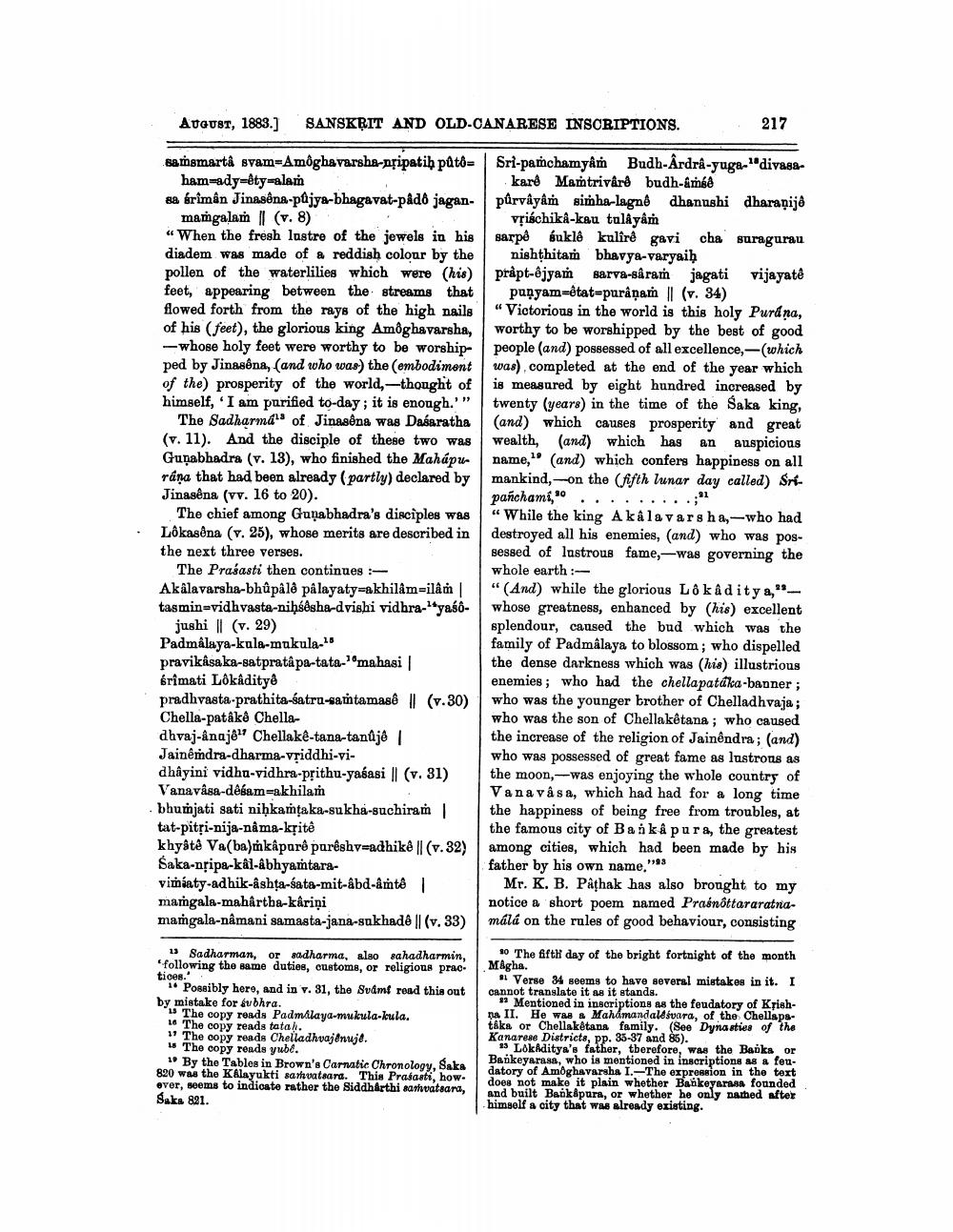________________
•
August, 1883.]
SANSKRIT AND OLD-CANARESE INSCRIPTIONS.
217
samsmartå svam-Amoghavarsha-nripatih påtô=
ham=ady-êty=alam sa sriman Jinasena-pujya-bhagavat-pådd jagan-
mamgalam || (v. 8) “When the fresh lastre of the jewels in his diadem was made of a reddish colour by the pollen of the waterlilies which were (his) feet, appearing between the streams that flowed forth from the rays of the high nails of his feet), the glorious king Amoghavarsha, -whose holy feet were worthy to be worshipped by Jinashna, (and who was) the (embodiment of the prosperity of the world, thought of himself, I am purified to-day; it is enough.'"
The Sadharma's of Jinasena was Dasaratha (v. 11). And the disciple of these two was Guņabhadra (v. 13), who finished the Mahápurána that had been already (partly) declared by Jinasena (vv. 16 to 20).
The chief among Gunabhadra's disciples was Lôkasåna (v. 25), whose merits are described in the next three verses.
The Prasasti then continues :Akalavarsha-bhûpâlê pâlayaty-akhilâm=ilâm | tasmin=vidhvasta-niņšêsha-dvishi vidhra-yaśô
jushi || (v. 29) Padmålaya-kula-mukula-15 pravikksaka-satpratâpa-tata-mahasi érimati Lôkâdityê pradhvasta-prathita-satru-samtamasê || (v.30) Chella-patêkê Chelladhvaj-ånajêu Chellake-tana-tanuje Jainêṁdra-dharma-vriddhi-vidhầyini vidhu-vidhra-prithu-yasasi || (v. 31) Vanavåsa-desam-akhilam bhumjati sati nihkamtaka-sukha-suchiram tat-pitri-nija-nama-krité khyatê Va(ba) kâparê parêshv=adhike || (v.32) Saka-ntipa-kal-abhyantaravimiaty-adhik-ashța-sata-mit-abd-&mtól mamgala-mahårtba-kåriņi mamgala-nâ mani samasta-jana-sukhado || (v. 33)
Sri-pamchamyam Budh-Ardra-yuga-"divaga
karê Mamtrivarð budh-ambe purvâyên siha-lagnê dhanushi dharanije
vriáchika-kau tolâyâm sarpė buklé kulîrê gavi cha suragurau
nishțhitam bhavya-varyaiḥ pråpt-êjyam sarva-sâram jagati vijayaté
paņyam=étatpurâņam || (v. 34) “Victorious in the world is this holy Purdna, worthy to be worshipped by the best of good people (and) possessed of all excellence,-(which was), completed at the end of the year which is measured by eight hundred increased by twenty years) in the time of the Saka king, (and) which causes prosperity and great wealth, (and) which has an auspicious name,'' (and) which confers happiness on all mankind,on the (fifth lunar day called) Sripanchami,. .........;"1 “While the king Akalavarsha,--who had destroyed all his enemies, (and) who was possessed of lustrous fame, -was governing the whole earth :" (And) while the glorious Lokaditya," whose greatness, enhanced by (his) excellent splendour, caused the bud which was the family of Padmâlaya to blossom; who dispelled the dense darkness which was (his) illustrious enemies; who had the chellapatáka-banner; who was the younger brother of Chelladhvaja; who was the son of Chellaketana; who caused the increase of the religion of Jainêndra; (and) who was possessed of great fame as lustrons as the moon,--was enjoying the whole country of Vana và sa, which had had for a long time the happiness of being free from troubles, at the famous city of Ba á kápura, the greatest among cities, which had been made by his father by his own name."93
Mr. K. B. Pathak has also brought to my notice a short poem named Praśnôttararatnamálá on the rules of good behaviour, consisting
13 Sadharman, or adharma, algo sahadharmin, following the same duties, customs, or religious prac. tices."
1. Possibly here, and in v. 31, the Svámf read this out by mistake for évbhra.
1 The copy reads Padmalaya-mukula-kula. 16 The copy reads tatah. 11 The copy reads Chelladhvajênuje. 15 The copy reads yube.
1. By the Tables in Brown's Carnatic Chronology, Saka 820 was the KAlayukti sarhvatsara. This Prasasti, how. ever, soems to indicate rather the Siddharthi sarlatsand, Saks 821.
#0 The fifth day of the bright fortnight of the month Mågha.
Verse 34 seems to have several mistakes in it. I cannot translate it as it stands.
Mentioned in inscriptions as the feudatory of Krishna II. He was a Mahamandal/svara, of the Chellaps. tiks or Chellaketana family. (See Dynasties of the Kanarese Districts, pp. 35-37 and 85).
13 LokAditya's father, therefore, was the Banks or Bankeyarasa, who is mentioned in inscriptions as a feu. datory of Amoghavarsha I.-The expression in the text does not make it plain whether Bankoyarsas founded and built Bank&pura, or whether he only named after himself a city that was already existing.




